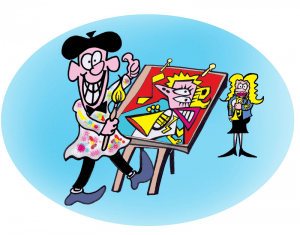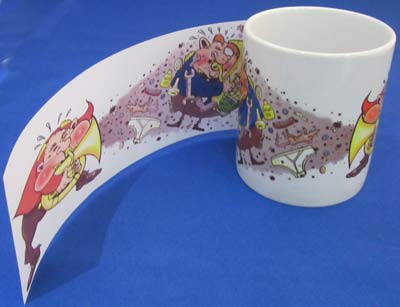20 top tips to show you how to become a cartoonist
 How to become a cartoon artist more easily!
How to become a cartoon artist more easily!
If you have a burning desire to draw cartoons and get paid for drawing there are certain things you need to do to move you towards this target.
There are many different jobs available such as freelance comic book artists, editorial cartoonists and many more. But unless you are screaming from the top of your voice “I want to be a cartoonist” with unwavering grit and determination it can be tough to get there! These are the main elements to show you how to become a cartoonist and are really important in allowing you to develop and maintain your artistic progress.
1. Routine
Get into a routine that works for you and stick to it. If you find that while jogging or walking you get a lot of ideas then do lots of jogging or walking. Plan out the times that you are going to draw or sketch out ideas and make it a routine until it becomes a habit.
2. Motivation
Sit down every morning – on sheet of paper write out your goals for the day. This should include cartooning goals and all the other stuff that you need to do. Get any non-cartoony important tasks out of the way so that they’re not playing on your mind. Once you have done all the other boring stuff get down to doing some serious cartooning even if it’s only for a short period of time. I find an e.ggtimer.com is very useful as it is sits on your computer screen and focuses you to do a task in a given time. Just beware it gives out an ear splitting bleep after the time has run out!
3. Recording ideas
Keep a voice recorder with you so that you don’t have to stop what you’re doing. Most mobile phones have this facility on them and its’ worth its weight in gold as you can listen to it later and not have to rely on your memory. If you have time to stop and make a note most phones have a note taking facility. A really useful App’ is Evernote which can store and send notes and e mail recordings to your computer. Technology is now so good that you never need to lose a brilliant idea because of a bad memory! As an alternative keep a sketchbook /notebook with you at all times to quickly scribble down or sketch out ideas.
4. Never say no
When you are starting out you shouldn’t refuse any work even if you don’t get paid for it or think you might not enjoy doing it as it may lead to other things. It also forces you to practice for real – you have to produce great work.
5. Try out your cartoons on friends and family
They might not tell you the truth. They might just say your cartoons are good even if they are rubbish – but at least you will have some feedback and maybe a few hints on how to improve. At least you will have a readymade 24/7 audience to look at your masterpieces.
6. Study other cartoonists work.
This is an invaluable reference source. Study the cartoons and ask yourself why does it work and then ask yourself how can you improve your own work to make yours better. Look at how they have laid out the scene, the characters and any text. How does the caption work with the image? By doing this you will immerse yourself in the professional cartoonist’s world and some of it will rub off on you.
7. Don’t copy other people’s cartoons.
It’s good to look at other cartoonists styles but you need to develop your own. It will come in time – honestly
8. Build a reference library of cartoon books and comics.
These are often a great incentive and source of inspiration when you get cartoonist block. Scouring the Internet from time to time – browsing other cartoonists work and ideas can also be a great source to new cartoon work.
9. Dealing with ‘cartoonists block’
If you do get cartoonist block try mind mapping for more ideas. Take a look at my blog post on ‘10 simple steps to find great original cartoon ideas’ to give you some inspiration if you ever get stuck.
10. Build a portfolio
If you keep a portfolio of your own work you will always have something to show a potential customer, lots of your own ideas and reusable cartoons. I often reuse characters or objects in Photoshop as you can just drag them into a cartoon, resize, recolor, saving hours of work. I always keep my paper based cartoons in folders as you never know when you might need something for a T shirt design, poster or web site image.
11. Make sure you keep to your deadlines
Nobody likes a cartoonist who can’t come up with the goods on time. Being reliable is a massive plus to any customer and enhances your reputation.
12. Be nosey!
Listen to what people talk about and say. People are the best source of humor and inspiration you can find. I often listen to people on buses and trains and eavesdrop on conversations. I have got some of my best work from doing this.
13. Don’t be a technophobe!
Don’t be afraid of new technology. Pen paper and paint paintbrushes are great but if you can get into computer technology with the vast array of software that is available it will really help you. Adding colour to cartoons, resizing, cropping and a whole host of other tools that are on offer are essential if you want to produce high-quality work.
14. Change is good!
Don’t be afraid to alter and develop your style. Your style of drawing will change over time and improve.
15. Keep smiling even when there isn’t a customer in sight
Don’t worry if there is no work coming in. This is common with the cartoonist suddenly find that you got more work than you can shake an inkpot at.
16. Focus on your weak spots
If there is an aspect of the cartooning that you struggle with like hands, expression or something else practice it at every opportunity. If you really struggle take a look at other cartoonists work and see how they do it. If you do this the problem will soon go away. I always struggled with hands and took a good look at Carl Giles cartoons (UK Daily Express) – he was wonderful at drawing hands.
17.Be with it!
Keep up with new trends and fashions to keep your cartoon ideas fresh.
18.Get used to rejection
Don’t let it get you down when you get your work turned down by editors and ‘gate keepers’ in publications. Most of the great cartoonists could wallpaper their house with the rejection slips. Keep at it and eventually you will break through!
19.Look out for publications without cartoons
Before you get paid jobs a useful trick is to approach publications that have not got a cartoonist and offer to do them a cartoon free. This gets you into the swing of dealing with business owners, meeting deadlines and creating work to a high level. It’s also a huge buzz to see your work in print and you can use it to show future customers that you have work in print!
20.Fun! Fun! Fun!
Make sure that you enjoy cartooning or what’s the point of doing it in the first place – there are easier ways of earning a living if you are a miserable artist!!!
Can you see yourself on a cartoonist salary in the future?
So do you think you are up for it? A career in cartooning – wouldn’t that be something! if you work hard and dedicate yourself to improving and exploring opportunities why not? I don’t believe in ‘luck’. I believe that you create your own opportunities in life by putting yourself in the right position or situation, so that you can achieve what you desire – there is an old saying which I believe is absolutely true… THE HARDER YOU WORK THE LUCKIER YOU GET!
If you wondered what it is like to become a professional cartoonist my blog post ‘so you want to be a cartoonist – the best job in the world’ will give you some answers.
 Idea for an art based business opportunity
Idea for an art based business opportunity
This article on craftsfinder.com may interest you if you are looking for a product with your cartoons to sell.
Turning blank Ceramic mugs into an Art Business is relatively inexpensive to set up and doesn’t require a university degree to produce the finished mugs. There are two articles:
- How to print your own sublimation mugs – turn blank mugs into cash!
- What equipment you will need to set up a mug sublimation business
